- This page refers to stoves using a fuel, usually solid. For solar versions, see Solar cooking
Improved solid biofuel stoves, smokeless stoves or wood conserving stoves are solid biofuel stoves designed to be at least 10% more fuel efficient than regular solid biofuel stoves or reduce the health problems associated with traditional cooking fires. They are widely used in developing countries and are often very simple designs. These designs, when they work as intended, don't fill the home with harmful smoke (through more efficient burning to reduce smoke, and a chimney or venting to remove that smoke), and use less fuel. Several designs have been developed depending on the local materials available, environmental conditions, and community needs.
-
fig 1: A selection of improved cook stoves
-
fig 1a: Open Fire Cookstove
-
fig 1b: Patsari improved cookstove made of bricks and mortar and ruble filling
-
fig c: Lorena cookstove made of rammed earth
-
fig d: Women can design and Manufacture improved cook stoves. ©Simon Ekless/Practical Action
Projects on Appropedia[edit | edit source]
Health impact[edit | edit source]
Cooking and heating with solid fuels such as wood, dung, coal or crop waste over open fires or stoves without chimneys can lead to indoor air pollution. This indoor smoke contains carbon monoxide, benzenes, aldehydes, small soot and dust particles and other health-damaging pollutants. A WHO assessment found indoor air pollution to be the 8th most important risk factor for disease. It is a particularly important risk factor for acute respiratory tract infections (ARI) including bronchitis and pneumonia. Each year, IAP is implicated in the deaths of 1.6 million people ( a death every 20 seconds). Because women and children spend the most time near the domestic hearth, they are especially vulnerable.[1]
Use of cleaner burning fuels, access to improved stoves and/or behavior changes could substantially reduce exposure to indoor smoke and associated diseases.[2]
-
Fig 2a: Open fire or fogon in use, while improved cook stove goes unused in the background. This might happen due to preference for taste or tradition of open fire or because different cooks in the house might not all know how or even want to cook on the improved stove.
-
Fig 2b: Roof blackened from years of open fire, even with large openings for air circulation between roof and wall smoke rises and then sinks rather than escaping to the outside.
-
Fig 2c: Lady cooking without lids during cooking test. When cooking with lids fuel use is reduced by 40%, a change which can save more fuel then switching to improved cooking stoves.[3]
-
Fig 2d: Improved cook stove in use without comalW so the dish receives direct heat. In the morning this produces little smoke, but by the afternoon the smoke no longer escapes out the chimney. It rises through the comal opening into the house.
-
Fig 2e: Improved Cookstove in Kenya ©Neil Cooper/Practical Action
Fuel conservation and Fuel efficiency[edit | edit source]
The world's forests are shrinking under tremendous pressure from agricultural and lumbering activities. In some areas, the intensifying search for fuelwood, the primary cooking fuel for the South, is an important contributor to the problem. Most of this wood is burned in open fires or inefficient stoves. When wood is simply too expensive or too far away, animal manures and crop residues formerly returned to the soil as fertilizers frequently are burned as fuel instead. This practice, increasingly common in many parts of Africa and South Asia, adds to a downward spiral in soil fertility. Once the trees and vegetation on hillsides are removed, soil erosion proceeds rapidly with rain water runoff and flooding, and the land can be turned into a desert. Current patterns of daily firewood consumption around the world are thus important factors in an advancing environmental crisis.
Since the late 1970's, much work has been done on the design and dissemination of simple, low-cost improved cookstoves. Such stoves can save up to 40% of the wood fuel normally consumed in open fires, and 25-35% of the fuel consumed in typical traditional stoves. The collective experience of this work is described in Burning Issues. After much enthusiastic pursuit of a variety of strategies to encourage owner-building of stoves, experienced observers are concluding that the small industry production of stoves is one of the most promising routes to take. The advantages of this approach include better quality control and therefore higher efficiency and longer stove life than can be achieved with owner-building. Costing $1-5 each, the stoves can often pay for themselves in fuel savings within 1-2 months if the fuel is purchased. In rural areas where most fuel is gathered, very low-cost stoves can still be sold to some people, but the distribution problem is much more difficult, and clearly successful strategies have yet to be worked out.
Fuel conservation through improved cookstoves appears to be the cheapest way for a nation to invest in new sources of energy. The typical artisan-produced cookstove conserving 35% of fuelwood costs less than $5. Three improved stoves have the same effect on fuel supply as one family biogas plant (which would cost 40- 50 times as much) - both mean that one additional family's cooking fuel needs can be supplied. The capital investment will be higher for electric or kerosene stoves, and one must also consider the cost of adding to the electrical generating capacity and extending the electrical grid. Both electric and kerosene stoves have the added daily cost of fuel, which in the case of the improved stove is nil (because improved efficiency alone accounts for all of the gain). The common subsidies and the foreign exchange requirements make kerosene imports burdensome for the national economies of many countries.
The secondary effects of existing cooking systems must be understood before acceptable improvements can be made. In many places, smoke from indoor cooking fires is a significant contributor to lung and eye disease. Yet this smoke also serves to dry crops hung over the cooking area and to protect thatched roofs from insect damage. In highland regions and other colder areas, the space heating function of the indoor cooking fire may need to be included in cookstove design. Successful stove promotion efforts may depend on the availability of effective alterations for these secondary functions of the cooking fire.
Experience has shown that despite the need for wood conservation on a massive scale, adoption of improved stoves cannot occur immediately for an entire nation or region. It will, instead, depend on involvement of local people in careful, systematic work which emphasizes testing and cooking methods. Existing stoves and new prototypes can be tested with a minimum of equipment. Testing techniques are covered by several of the books in this section.
Most knowledgeable people have revised their estimates of the fuel savings possible with the typical new stove. A 35% savings is now considered a realistic figure for the better stove designs. Similarly, most agree that the distribution of improved stoves alone is not going to greatly affect the rate of deforestation in most places. Nevertheless, improved cookstoves are now considered to be a cost-effective component in reforestation programs in some countries, and clearly they have a role to play in improving the quality of life by conserving family resources of cash and time, and reducing smoke in the cooking area.
Many thanks to David Bartecchi of Village Earth for the initial content.
Key Design Features[edit | edit source]
Some or all of these design features help make a stove more fuel efficient or reduce health problems associated with taditional cooking fires:
- Long chimney or vent - to remove smoke to outdoors, and improve airflow through the fire.
- Controllable air inflow - requires the fire to be in an enclosure with an adjustable inlet - allows reduction of burning rate to match needs.
- Use of a material with good insulating properties, for the inside walls of the stove - usually ceramic.
- Afterburning - mixing the flue (exhaust gas) with a small amount of new air, to allow the last remaining hydrocarbons and carbon monoxide to burn without a flame.
- Jacketing the cooking vessel, i.e. making the hot flue travel through a narrow passage between the cooker and the pot. This implies that the pot size and cooker size must be matched.
- Use of the flue gas heat for space heating (in cold climates) and/or water heating. To avoid leakage of flue gas into the room, a heat exchanger is needed. In an expensive product this may be a complex stainless steel device, or in a developing nation a simple metal flue pipe.[expansion needed]
- Many societies cook only a few types of food and you should design the stove to meet their specific needs
- If they stir a thick material, you will need a well supported base in order to keep the cooker stable
- There is an optimal separation between the pot and the cooker to allow for the airflow to escape. Design the stove to match the pots and maintain this separation
- If too much material is placed in the burner, not all of the hydrocarbons will be consumed, so consider limiting the amount of space for the flamable material. Also consider what type of material is burned locally when designing this burning area
- In densely populated areas such as refugee camps, multiple households will want to share the stoves, so consider including insulated handles.
- As always with appropriate technology, the stoves should be locally constructed with local materials, using local techniques. This way, you can seed entrepreneurs to produce, sell and repair the stoves after you leave.
- an enclosed fire to retain the heat
- careful design of pot holder to maximise the heat transfer from fire to pot
- baffles to create turbulence and hence improve heat transfer
- dampers to control and optimise the air flow
- a ceramic insert to minimise the rate of heat loss
- a grate to allow for a variety of fuel to be used and ash to be removed
- metal casing to give strength and durability
- multi pot systems to maximise heat use and allow several pots to be heated simultaneously
Much of the research and development work carried out on biomass technologies for rural areas of developing countries has been based on the improvement of traditional stoves. This was initially in response to the threat of deforestation but has also been focused on the needs of women to reduce fuel collection times and improve the kitchen environment by smoke removal. There have been many approaches to stove improvement, some carried out locally and others as part of wider programmes run by international organizations. Figure 2 below shows a variety of successful improved stove types, some small, portable stoves and others designed for permanent fixture in a household.
Improving a stove design is a complex procedure which needs a broad understanding of many issues. Involvement of users in the design process is essential to gain a thorough understanding of the user’s needs and requirements for the stove. The stove is not merely an appliance for heating food (as it has become in Western society), but is often acts as a social focus, a means of lighting and space heating. Tar from the fire can help to protect a thatched roof, and the smoke can keep out insects and other pests. Cooking habits need to be considered, as well as the lifestyle of the users. Light charcoal stoves used for cooking meat and vegetables are of little use to people who have staple diets such as Ugali, which require large pots and vigorous stirring. Fuel type can differ greatly; in some countries cow dung is used as a common fuel source, particularly where wood is scarce. Cost is also a major factor among low-income groups. Failing to identify these key socio-economic issues will ensure that a stove programme will fail. The function of an improved stove is not merely to save fuel.
Improved cook stove materials[edit | edit source]
One of the most important aspects of improved cook stove design is what materials you use.
Important considerations:
- The material must be able to stand up to thermal cycling
- Price: people won't buy an expensive stove
- The material must be available (obvious, but worth saying)
Materials to consider
- Refractory brick (designed to insulate and withstand thermal cycling)
- Clay/Mud brick (cheep)
- Refractory Concrete
- Normal Concrete
- Sheet metal (keep in mind that a stove that doesn't cause burns is very important)
- Normal Tile
- Insulated Tile
For combustion chambers, keep in mind that the wood can be shoved in with considerable force and the chamber should be able to stand up to some abuse
Metals:
- Zinc has a relatively low melting temperature and should not be used for high heat applications.
- Stainless steel can be adequate for combustion chambers
- Cast Iron works very well but it is very expensive.
Local manufacture of stoves[edit | edit source]
Since 1982, the Kenya Ceramic Jiko (KCJ), an improved charcoal-burning stove aimed at the urban market has been developed and manufactured by large numbers of small producers. The KCJ has two main components; metal and fired clay. Both these parts are made by entrepreneurs; the metal part (cladding) being made by small-scale enterprises or individual artisans, while the clay part (liner) is manufactured by slightly larger and more organised enterprises or women’s groups. The KCJ is sold by the artisans directly to their customers or through commercial outlets such as retail shops and supermarkets. The stove was initially promoted heavily to develop the market, by the NGO KENGO and by the Kenyan Ministry of Energy, through the mass media, market demonstrations and trade fairs. As a result of this substantial promotion, there are now more than 200 artisans and micro-enterprises manufacturing some 13,600 improved stoves every month. To date, it is estimated that there are some 700,000 such stoves in use in Kenyan households. This represents a penetration of 16.8% of all households in Kenya, and 56% of all urban households in the country.[4]
Ongoing research and development[edit | edit source]
Groups including the Kobus Venter's Vuthisa Technologies[5] and EWB San Francisco Professionals Chapter[6] are doing research into optimizing such stoves, including using briquettes made from waste biomass (e.g. agricultural waste) with a simple briquette press.
The fuel used can have a great impact on the smoke produced, as well as affecting the environmental impact. CharcoalW is much cleaner burning than wood or dung, but is usually made from wood.
Amy SmithW has done work on producing charcoal from other forms of biomass. To make the biomass stick together, a binder is used. (Another method of making briquettes more cohesive is to leave the biomass in water for a couple of days to decompose slightly.) The choice of biomass depends on what is widely available, but includes bagasseW (sugar cane waste) bound with a paste of cassavaW root (also called manioc or tapioca); and wheat or rice straw bound with a small amount of dung, in areas where pure dung is normally burnt.[7]
A program called CFD-GEOM can be used to model cookstove designs.
The Wood gasification stove is probably the most efficient stove design possible.
Different Improved Cookstove Designs[edit | edit source]
- Aprovecho rocket stoves, Cottage Grove, Oregon
- HSU Chiapas Improved Cookstoves Patsari and Lorena cook stoves compared in Mexico
- HELPS plancha stove in Guatemala
- PROLENA EcoStove in Nicaragua
- Justa stove in Honduras
- ProBec stoves in South Africa
- GTZ stoves in Africa
- BioLite Home Stove: a wood-based cooker that also has a built-in electricity generator
Notes and references =[edit | edit source]
- ↑ World Health Organization
- ↑ Randomized Exposure Study of Pollution Indoors and Respiratory Effects (RESPIRE) Trial
- ↑ http://www.peprimer.com/stove.html#SECTION5
- ↑ Source: Dominic Walubengo, Stove Images, 1995
- ↑ Vuthisa Technologies is a small company in Pietermaritsburg, Kwa Zulu Natal, South Africa, and Kobus Venter discussed (or discusses) the development of the design on the Biomass cooking stoves lists.[expansion needed]
- ↑ EWB-SFP Appropriate Technology Design Team's blog, with a strong focus on improved stoves. See also Darfur Cookstoves - Updates May-December 2006
- ↑ MIT's Amy Smith on third-world engineering: TEDTalks - Video on YouTube.
See also[edit | edit source]
External links[edit | edit source]
- Aprovecho Research Center
- Brookhaven National Laboratory, 2023, Wood Heater Design Challenge Workshop Report, Report for U.S. Department of Energy, Bioenergy Technologies Office, Report No. 224406, https://www.energy.gov/eere/bioenergy/articles/just-released-new-wood-heater-design-challenge-workshop-report
- BuildItSolar: Wood stoves; of particular intrest are the RootSimple rocket stove and the water-heating wood stoves
- Design Principles for wood burning cook stoves
- Information on various Improved Cook Stoves
- http://iapstoves.blogspot.com/
- Large amount of cook stove information - including active email discussion group
- Wikipedia:Cook stove
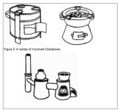


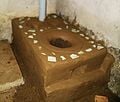

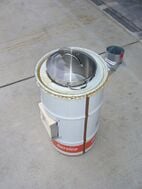
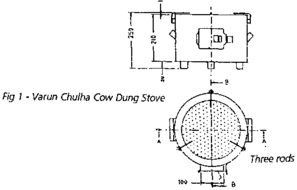

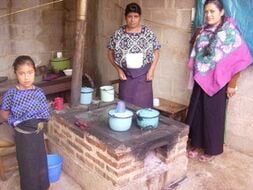
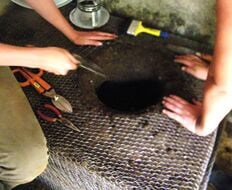
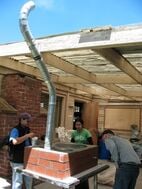



![Fig 2c: Lady cooking without lids during cooking test. When cooking with lids fuel use is reduced by 40%, a change which can save more fuel then switching to improved cooking stoves.[3]](/w/images/thumb/9/9d/100_1312.JPG/120px-100_1312.JPG)

